
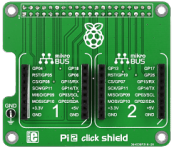
|
Pi 2 click Shield (for Raspberry Pi) Released

Pi 2 click shield is an extension for Raspberry Pi models 2B and B+. Compared to the original Pi click shield, this one conforms to the expanded pinout of newer Raspberry Pi models. The Raspberry Pi 2 B has a quad-core ARM Cortex-A7 with six times the performance of the original Pi. To take advantage of increased processing powers, Pi 2 click shield carries not one but two mikroBUS sockets. This makes your credit card sized computer compatible with over a 100 click boards, carrying all sorts of sensors, transceivers, motor drivers, encoders, connection ports etc.
|
2015/06/10 |

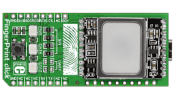
|
Fingerprint click Released

Fingerprint click is a click board solution for adding biometric security to your design. It carries the GTS-511E2 module, which is the thinnest optical touch fingerprint sensor in the world. The module comprises a CMOS image sensor with a special lens and covering that records real fingerprints while resisting 2D fakes. The click board also carries an STM32 MCU for processing the images and forwarding them to an external MCU or PC. We created a Windows application that provides an easy interface for communicating with Fingerprint click. The board is designed to use a 3.3V power supply.
|
2015/06/08 |

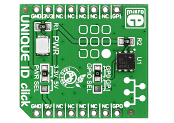
|
Unique ID click Released

Unique ID click carries DS2401, an enhanced silicon serial number IC. It's a low cost solution for providing a unique registration number to your design. The chip consists of a factory-lasered 64-bit ROM that includes a uniques a 48-bit serial number, an 8-bit CRC, and an 8-bit family code. It uses 1-wire communications for interfacing with the target board microcontroller, either through a GP1 or GP0 pin (here in place of the default AN and PWM mikroBUS pins). The board is designed to use either a 3.3V or 5V power supply.
|
2015/06/08 |

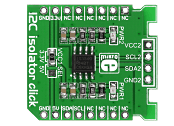
|
I2C Isolator click Released

I2C Isolator click carries ISO1540, a low-power, bidirectional isolator compatible with I2C interfaces. On the board, the Texas Instruments chip is connected to two sets of I2C pins, one on the mikroBUS connector (SDA, SCL), the other on the upper edge of the board (SCL2, SDL2). ISO1540 uses a silicon dioxide barrier that separates the logic input and output buffers. Bidirectional isolators based on TI's Capacitive Isolation technology have many advantages over opto-couplers (performance, size, power consumption etc.). When used together with isolated power supplies, they block high voltages, isolate grounds, and prevent interference from from noise currents.
|
2015/06/08 |


|
Proximity 2 click Released

Proximity 2 click features the MAX44000, an IC that integrates an ambient light as well as a proximity sensor. The chip consists of an array of photodiodes that convert light into current, which the internal circuitry then converts into a digital value. The light sensor has a dynamic range of 0.03 to 65.535 lux. The IR proximity detector is matched with an integrated IR LED driver (for the onboard high power infrared LED). Proximity 2 click communicates with the target board microcontroller through mikroBUS I2C (SCL, SDA), and INT lines. It is designed to use a 3.3V power supply only.
|
2015/06/08 |


|
ETH WIZ click (Ethernet) Released

ETH Wiz click carries W5500, a 48-pin, 10/100 BASE-TX standalone ethernet controller with a hardwired TCP/IP Internet protocol offload engine, along with a standard RJ-45 connector. The W5500 module employs a variety of solutions to reduce the target MCU's memory load and enable a stable and secure Internet connection. High speed network communications are realized through an 80 MHz SPI interface. The module has 32KB of internal memory for TX/RX buffers. Reduced power consumption is achieved with Wake on LAN and power down modes. Automatic handshaking, retransmit on collision and automatic rejection of erroneous packets are also supported.
|
2015/05/15 |

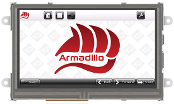
|
Armadillo-43T (Raspberry Pi) Released

The Armadillo-43 is a complete Linux based computer module with a built-in 480x272 TFT LCD display.
The board is designed to be a Raspberry Pi with built-in display, and features the same Broadcom BCM2835 System-On-Chip (SoC) which is found on the Pi.
|
2015/05/13 |


|
mikroMedia 7" for STM32F4 Released

Mikromedia 7 for STM32F4 is a 7" display board powered by the proven STM32F407ZG with 168 MHz operation (210 DMIPS), 1 MB of Flash and 192 + 4 KB of SRAM. The board also features various modules such as an accelerometer, microSD card slot for external storage, MP3 Stereo Codec chip, WiFi module, CAN interface and ethernet connector.
|
2015/05/13 |


|
nRF S click (nRF24L01) Released

The nRF S click is a compact and easy solution for adding a 2.4 GHz transceiver to your design. It features a nRF24L01P 2.4 GHz transceiver module with an embedded baseband protocol engine as well as an SMA antenna connector (antenna sold separately). The board supports an air data rate of 250 Kbps, 1 Mbps and 2 Mbps and it is suitable for ultra low power designs. Typical applications include wireless PC peripherals, remotes, VoIP headsets, game controllers, sensors, home and commercial automation, active RFID, toys, etc. nRF S click communicates with target board microcontroller via mikroBUS SPI (SDI, SDO, SCK, CS#), CE and INT lines. The board is designed to use a 3.3V power supply only.
|
2015/05/13 |


|
AlphaNum click Released

AlphaNum click is a simple solution for adding 14-segment alphanumeric display to your device. The board carries two TLC5926 16-bit Constant-Current LED sink Drivers as well as a dual character green or red LED 14-segment display (with two additional segments for commas). AlphaNum click communicates with the target board through mikroBUS RST, CS, SCK, MISO, MOSI, PWM and INT pins (marked here as LE2, LE1, CLK, DOUT, DIN, NUMSEL and NUMSEL respectively). The board is designed to use either a 3.3V or 5V power supply.
|
2015/05/05 |

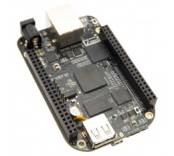
|
BeagleBone Black

Due to customer demand, we are now also selling BeagleBone Black (Rev C).
BeagleBone Black is a tiny, low-cost, internet enabled, open source and community-supported development platform which runs a variety of OS including Debian, Angstrom and Ubuntu Linux as well as Android.
We also have 4.3" and 7" displays available for the BBB, as well as a Cape for easily adding "click" Accessory Boards for extended functionality.
|
2015/04/28 |

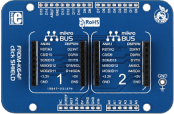
|
FRDM-K64f click shield Released

FRDM-K64F click shield is an extension for Freescale's FRDM-K64F development platform. It's a simple shield with two mikroBUS host sockets that allow you to interface more than 100 different types of click boards with the Kinetis MK64FN1M0VLL12 MCU aboard FRDM-KL64Z. Quickly add functionalities like GSM, GPS, WiFi, ZigBee, Bluetooth, or thunder detection, proximity and color sensing and so on. The package includes two 1x8 headers, and single 1x10, and 1x6 headers.
|
2015/04/22 |

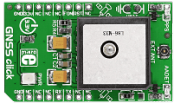
|
GNSS click Released

GNSS click carries Quectel’s L86 GNSS module with a patch antenna along with an external antenna connector. GNSS stands for Global Navigation Satellite System, an umbrella term that describes both the United States GPS and the Russian GLONASS global positioning systems. Excluding its wider applicability, the L86 module is similar to the L80 module (used on GPS3 click). It includes the same set of technologies: automatic prediction of orbits from internally stored data, adaptive adjusting of on/off time to balance between positioning accuracy and power consumption etc. The board uses a 3.3V power supply.
|
2015/04/21 |


|
Camera click Released

Camera click carries OV7670-VL2A, a low voltage CMOS image sensor, connected to an onboard FT900 MCU through a parallel camera interface. The FT900 in turn outputs the camera image to the target board microcontroller through the mikroBUS SPI interface (CS, SCK, MISO, MOSI). An additional RDY pin (INT) signals the camera’s status. Camera click combined with a 32-bit target board MCU will enable you to stream QCIF resolution video (176 x 144 px). Increased processing power and storage capabilities will get you better results (the maximum resolution of the OVO7670 sensor aboard camera click is VGA, 640x480). With 8-bit MCUs, camera click is best used for rendering static images, or for specific applications where a few frames per second are enough.
|
2015/04/21 |

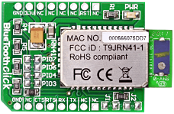
|
BlueTooth click Android App

A new example is available for BlueTooth click, featuring an open-source Android aplication. To view the example, please click here.
|
2015/04/10 |


|
Expand2 click Released

EXPAND 2 click is an accessory board in mikroBUS form factor. It includes the MCP23017 16-bit I/O expander which features an I2C interface and clock speeds up to 1.7 MHz. Three HARDWARE ADDRESS SEL jumpers allow you to configure the board address and connect up to eight devices on the bus. The controller also supports an interrupt-on-change feature, and has optional weak pull-ups on each input. Expand2 click is set to use a 3.3V power supply by default but you can solder PWR SEL SMD jumper to the 5V position if used with 5V systems.
|
2015/04/10 |

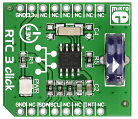
|
RTC3 click Released

RTC3 click carries BQ32000, a real time clock with an integrated trickle charge circuit for automatic switchover to a backup power supply (the circuit maintains the backup charge with an onboard super capacitor). The clock frequency is derived from an onboard 32.768KHz oscillator. RTC3 click communicates with the target board microcontroller through mikroBUS I2C lines: SCL, SDA. In addition, the INT pin serves as a configurable interrupt output. The board is designed to use a 3.3V power supply only.
|
2015/04/08 |

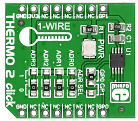
|
Thermo2 click Released

Thermo 2 click carries DS1825, a programmable resolution digital thermometer IC. It measures temperature within a range from - 10°C to 85°C with +/-0.5°C accuracy. You can specify the resolution of the measurements, from 9 to 12-bit, depending on the application. The board communicates with the target microcontroller through a 1-wire interface. Using the onboard jumper, you can choose between two mikroBUS pins for setting the output. Thermo 2 click also features four Address Select jumpers for setting a unique ID for the sensor (allowing for up to 16 sensors to operate on a single 1-Wire bus).
|
2015/04/08 |

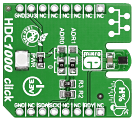
|
HDC1000 click (Temperature / Humidity Sensor) Released

HDC1000 click is a humidity (and temperature) measurement click board carrying the HDC1000 sensor from TI. Its chief features are low power consumption, precision, and resistance to dust, dirt, and similar environmental contaminants. The relative humidity (0-100%RH) is measured with an accuracy of ±3%; the temperature is measured within a range from -20°C to 85°C with ±0.2°C accuracy. HDC1000 click communicates with the target board MCU through mikroBUS I2C and INT lines. It operates as a slave device on the I2C interface. A pair of onboard jumpers allow you to specify the slave byte address, with four to choose from. The board is designed to use a 3.3V power supply only.
|
2015/04/01 |

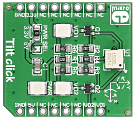
|
Tilt click Released

Tilt click carries a RPI-1035, 4-directional optical tilt sensor. This type of sensor provides positional feedback for left, right, backward or forward movement (tilt). Compared to mechanical solutions, optical direction detectors are less prone to noise caused by vibrations. Compared to magnetic-based direction detectors, they are not influenced by magnetic disturbances. Tilt click communicates with the target board microcontroller through mikroBUS PWM and INT lines, used here for vout1 and vout2 outputs from the sensor. In addition, two onboard LEDs provide visual feedback from the sensor. The board is designed to use either a 3.3V or 5V power supply.
|
2015/03/26 |

|

